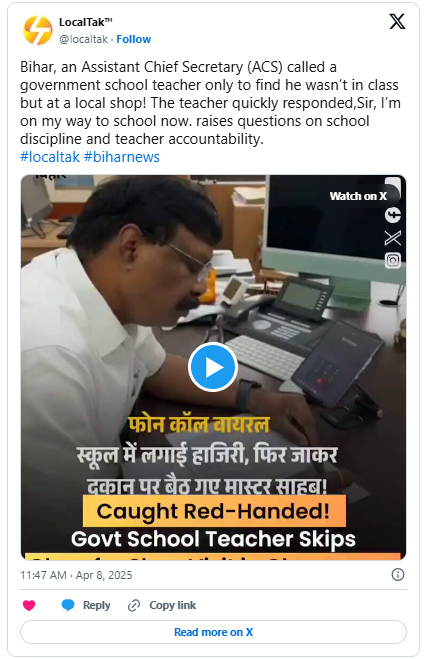A surprising incident in Bihar has put the spotlight back on school discipline and teacher accountability. An Assistant Chief Secretary (ACS), during a routine call to check on government school functioning, was shocked to find that the teacher he tried to contact was not in the classroom—but instead, at a local shop.
According to sources, the ACS called the teacher to inquire about school activities and student attendance. To his astonishment, background noise and conversations suggested that the teacher was not in a school environment. When questioned, the teacher admitted, “Sir, I’m on my way to school now,” raising eyebrows about his absence during class hours.
The incident has since gone viral on social media, drawing criticism from citizens and education advocates. Many are questioning the level of commitment some government school teachers show towards their responsibilities, especially in rural and semi-urban areas.
“This is not just about one teacher; it reflects a systemic issue,” said an education department official on the condition of anonymity. “If teachers are not present in classrooms during school hours, it directly affects the learning outcomes of students.”

Bihar’s education sector has faced longstanding challenges, from inadequate infrastructure to teacher absenteeism. The government has taken several measures in recent years to improve accountability, including biometric attendance systems and surprise inspections. However, incidents like this suggest that enforcement remains inconsistent.
Parents from the village where the incident occurred expressed frustration. “We send our children to school hoping for a better future. But if teachers aren’t there, what will our children learn?” asked one concerned father.
The ACS has reportedly ordered an inquiry into the matter, and disciplinary action may follow depending on the findings. Meanwhile, the Education Department has reiterated its commitment to ensuring that teachers remain accountable and present during working hours.
As this case continues to unfold, it serves as a stark reminder that ensuring quality education requires not only infrastructure and policy but also active participation and responsibility from those at the grassroots level.















 Categories
Categories










